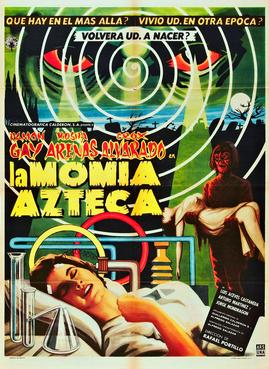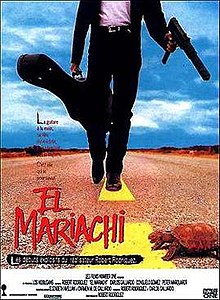
Horror is a film genre that seeks to elicit fear or disgust in its audience for entertainment purposes.

Mexican cinema dates to the late nineteenth century during the rule of President Porfirio Díaz. Seeing a demonstration of short films in 1896, Díaz immediately saw the importance of documenting his presidency in order to present an ideal image of it. With the outbreak of the Mexican Revolution in 1910, Mexican and foreign makers of silent films seized the opportunity to document its leaders and events. From 1915 onward, Mexican cinema focused on narrative film.

The corrido is a famous narrative metrical tale and poetry that forms a ballad. The songs are often about oppression, history, daily life for criminals, the vaquero lifestyle, and other socially relevant topics. Corridos were widely popular during the Mexican Revolution and in the Southwestern American frontier as it was also a part of the development of Tejano and New Mexico music, which later influenced Western music.
A narcocorrido is a subgenre of the Regional Mexican corrido genre, from which several other genres have evolved. This type of music is heard and produced on both sides of the Mexico–US border. It uses a danceable, polka, waltz or mazurka rhythmic base.
The Golden Age of Mexican Cinema is a boom period in the history of Mexican cinema, which began in 1936 with the premiere of the film Allá en el Rancho Grande, and Let's Go with Pancho Villa, culminated in 1956. Characterized by the production of high-quality films that contributed to shaping Mexican national identity and culture. Films such as Luis Buñuel's "Los Olvidados" illuminated the social realities of Mexico, leaving a profound impact on audiences both within the country and abroad.

Alejandro Muñoz Moreno, better known by the ring name Blue Demon, was a Mexican film actor and luchador enmascarado. Blue Demon is considered a legend of lucha libre, partially from starring in a series of Lucha films between 1961 and 1979, often alongside in-ring rival El Santo. His in-ring career began in 1948 and stretched for 41 years until his retirement in 1989.
Grupo Exterminador, is a Mexican norteño band. Though known for performing various song styles such as rancheras, cumbias, and ballads, they are especially famous for their brash narcocorridos.
El Monstruo Resucitado is a 1953 Mexican horror film directed by Chano Urueta and starring Miroslava, Carlos Navarro and José María Linares-Rivas.
During the ongoing Mexican drug war, drug cartels use propaganda through media and scare tactics to gain more control of its people and in many cases corrupting the government. The main goals are to glorify actions of the drug cartels and their lifestyle, gain control of the Mexican society to the highest extent possible, and to recruit new, educated, high-class members to increase their power even further. These drug cartels' use of propaganda and scare tactics are used in precise, complex, and clever ways to get the most out of every action, resulting in their enormous power.

José Alberto Ammann Rey is an Argentine and Spanish actor. He has played various roles in films, television and theater. His feature film debut in Cell 211 (2009) earned him a Goya Award for Best New Actor. Other film works include performances in Lope: The Outlaw (2010), Eva (2011), Invader (2012), Thesis on a Homicide (2013), Betibú (2014), The Year of Fury (2020), Presencias (2022), and Upon Entry (2022). He is also known for playing Colombian drug trafficker Pacho Herrera in crime television series Narcos and Narcos: Mexico.
Narcoculture in Mexico is a subculture that has grown as a result of the strong presence of the various drug cartels throughout Mexico. In the same way that other subcultures around the world that are related to crime and drug use, Mexican narco culture has developed its own form of dress, music, literature, film, religious beliefs and practices and language (slang) that has helped it become a part of the mainstream culture in some areas of the country, mainly among lower-class, uneducated youth. Narco culture is dynamic in that there are various regional differences within Mexico and among those who participate in it.

Florence Marly was a Czech-born French film actress. During World War II, Marly moved to neutral Argentina with her Jewish husband, film director Pierre Chenal, where she appeared in several films. She also acted in two of her husband's films while they were in Chile.

The Aztec Mummy is a 1957 Mexican adventure horror film produced by Guillermo Calderon from his own story idea, scripted by Alfredo Salazar, and directed by Rafael Portillo. The plot centers on a group of scientists who uncover a secret Aztec tomb through past-life regression, only to awaken an ancient warrior who has been cursed to guard the tomb and its hidden treasures. It is the first of a trilogy featuring the titular character, all filmed back-to-back in order to increase potential profit.
Frank Moro was a Cuban–American film and television actor.
Bernabé Melendrez, aka "El Gatillero" is a Mexican action film actor and, after his directorial debut in 2012, film director. He is also a singer.
The Mexican animation industry is a part of Mexico's domestic film industry. It utilizes primarily the flash, CG, and traditional animation formats, typically produced on a small budget. There studios included Ánima Estudios, Animex Producciones, Huevocartoon, among others. It began in 1915 with the first animated film of the country, Mi Sueño, and continues decades later.
Narco pelicula, also known as narco film or narco filme, is a sub-genre of Mexican cinema's action film and Mexploitation genres. It deals with movies about drug trafficking and drug cartels, usually but not exclusively fictitious ones.
Museo del horror is a 1964 Mexican mystery thriller horror black-and-white film directed by Rafael Baledón and starring Julio Alemán, Patricia Conde and Joaquín Cordero.
The Invasion of the Vampires is a 1963 Mexican horror mystery thriller film directed by Miguel Morayta and starring Erna Martha Bauman, Rafael del Río, Tito Junco, Fernando Soto, Bertha Moss and Carlos Agostí.







